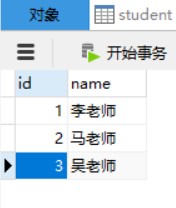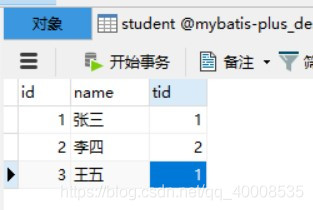Mybatis自定义SQL的关系映射 Mybatis自定义SQL的关系映射、分页、排序功能的实现
83年老蒜头 人气:0目的: 记录数据库表与实体对象之间不同的映射关系如何用mybatis的自定义sql和结果返回集处理。
1、三种对象映射关系
1.1 一对一
一个人对应一个SFZ,一位同学对应一个班级,每个房间都有自己的房间号,当一个事物它对应另一个事物是唯一的,那么它们之间的关系就是一对一的。
这里我演示的案例是,一个学生有着一位老师
老师基础信息:

学生详细信息:

如果说,我们需要将两个表一起查出来,我们可以这么做:
问题: 如果对象的列重复了,必须要使用到别名
1、先定义实体结构,也就是我们返结果的实体类
public class Student {
@TableId
private int id;
private String name;
private int tid;
@TableField(exist = false)
private Teacher teacher;
}
Teacher:
public class Teacher {
@TableId
private int id;
private String name;
}
2、 编写xml文件
这里有两种方式,使用association时的关键在于告诉mybatis如何加载关联(assocition)。
- 嵌套查询:通过执行另外一个 SQL 映射语句来返回预期的复杂类型。
- 嵌套结果:使用嵌套结果映射来处理重复的联合结果的子集。
第一种: 使用嵌套查询,也就是使用另一个sql
// teacherMapper.xml
<?xml version="1.0" encoding="UTF-8" ?>
<!DOCTYPE mapper
PUBLIC "-//mybatis.org//DTD Mapper 3.0//EN"
"http://mybatis.org/dtd/mybatis-3-mapper.dtd">
<mapper namespace="com.lll.mybatisplusdemo.mapper.TeacherMapper">
<select id="getTeacher" parameterType="int" resultType="teacher">
select * from teacher where id = #{id};
</select>
</mapper>
// studentMapper.xml
<?xml version="1.0" encoding="UTF-8" ?>
<!DOCTYPE mapper
PUBLIC "-//mybatis.org//DTD Mapper 3.0//EN"
"http://mybatis.org/dtd/mybatis-3-mapper.dtd">
<select id="getStudent2" parameterType="int" resultMap="getStudentMap2">
select * from student where id =#{id};
</select>
<resultMap id="getStudentMap2" type="student">
<id column="id" property="id"></id>
<result column="name" property="name"></result>
<result column="tid" property="tid"></result>
<association property="teacher" javaType="Teacher" column="tid" select="com.lll.mybatisplusdemo.mapper.TeacherMapper.getTeacher">
<id column="id" property="id"></id>
<result column="name" property="name"></result>
</association>
</resultMap>
</mapper>
嵌套查询的方式很简单,但是对于大型数据集合和列表将不会表现很好。问题就是我们熟知的
“N+1 查询问题”。概括地讲, N+1 查询问题可以是这样引起的:
- 你执行了一个单独的 SQL 语句来获取结果列表(就是“+1”)。
- 对返回的每条记录,你执行了一个查询语句来为每个加载细节(就是“N”)。
第二种: 使用嵌套结果来映射联合查询来的数据
<?xml version="1.0" encoding="UTF-8" ?>
<!DOCTYPE mapper
PUBLIC "-//mybatis.org//DTD Mapper 3.0//EN"
"http://mybatis.org/dtd/mybatis-3-mapper.dtd">
<mapper namespace="com.lll.mybatisplusdemo.mapper.StudentMapper">
<select id="getStudent" parameterType="int" resultMap="getStudentMap">
SELECT a.*,b.id as cid,b.name as cname FROM `student` as a,teacher as b WHERE a.id =#{id} and a.tid = b.id;
</select>
<resultMap id="getStudentMap" type="student">
<id column="id" property="id"></id>
<result column="name" property="name"></result>
<result column="tid" property="tid"></result>
<association property="teacher" javaType="Teacher">
<id column="cid" property="id"></id>
<result column="cname" property="name"></result>
</association>
</resultMap>
</mapper>
我们在相应的mapper中添加方法接口便可以使用了。
1.2 一对多
案例:一个老师有多个学生
1、实体类
public class Teacher {
@TableId
private int id;
private String name;
@TableField(exist = false)
private List<Student> students;
}
2、编写xml
同样还是,我们先来个嵌套结果映射
嵌套结果:
// teacherMapper.xml
<select id="getStudent" parameterType="int" resultMap="getStudentMap">
SELECT a.*,b.id as cid,b.name as cname,b.tid
from teacher as a , student as b
where b.tid = a.id and a.id =#{id};
</select>
<resultMap id="getStudentMap" type="teacher">
<id column="id" property="id"></id>
<result column="name" property="name"></result>
<collection property="students" ofType="Student">
<id column="cid" property="id"></id>
<result column="cname" property="name"></result>
<result column="tid" property="tid" ></result>
</collection>
</resultMap>
嵌套查询:
// teacherMapper.xml
<select id="getStudent2" parameterType="int" resultMap="getStudentMap2">
select * from teacher as a where a.id = #{id}
</select>
<resultMap id="getStudentMap2" type="teacher">
<id column="id" property="id"></id>
<result column="name" property="name"></result>
<collection property="students" column="id" ofType="Student" select="com.lll.mybatisplusdemo.mapper.StudentMapper.getStudentByTid">
</collection>
</resultMap>
// studentMapper.xml
<select id="getStudentByTid" parameterType="int" resultType="student">
select * from student as a where a.tid = #{id}
</select>
1.3 多对多
学生与课程是多对多的关系,与上面的一对多的操作方式是类似的
2、自定义sql如何做分页
mapper定义方法,方法传入page参数
public interface UserMapper{
IPage<User> selectPageVo(Page<User> page);
}
userMapper.xml文件编写一个普通的返回结果是list的方法,mybatis会自动帮你做分页
<select id="selectPage" resultType="com.baomidou.cloud.entity.UserVo"> SELECT * FROM user </select>
3、自定义sql如何做排序
结论:使用order by,记住要使用'$',不能使用'#'
<select id="selectPage" resultType="com.baomidou.cloud.entity.UserVo">
SELECT * FROM user order by ${sortColumn} ${sortOrder}
</select>
4、自定义sql中的#{}和${}的区别
1、传入的参数在SQL中显示不同
#传入的参数在SQL中显示为字符串(当成一个字符串),会对自动传入的数据加一个双引号。
例:使用以下SQL
select id,name,age from student where id =#{id}
当我们传递的参数id为 “1” 时,上述 sql 的解析为:
select id,name,age from student where id ="1"
$传入的参数在SqL中直接显示为传入的值
例:使用以下SQL
select id,name,age from student where id =${id}
当我们传递的参数id为 “1” 时,上述 sql 的解析为:
select id,name,age from student where id =1
2、#可以防止SQL注入的风险(语句的拼接);但$无法防止Sql注入。
3、$方式一般用于传入数据库对象,例如传入表名。
4、大多数情况下还是经常使用#,一般能用#的就别用$;但有些情况下必须使用$,例:MyBatis排序时使用order by 动态参数时需要注意,用$而不是#。
加载全部内容